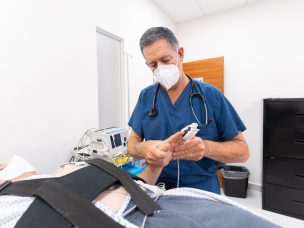Contributions
Understanding Left Atrial Infiltration in Patients With ATTR-CM
The infiltration of left atria in patients with ATTR-CM can have various effects, all of which can be tracked in different ways. This study provides some insight into how it can be tracked, and its clinical significance. The involvement of left atrial pathology in patients with transthyretin amyloid cardiomyopathy (ATTR-CM) is of significant clinical interest....
The Correlation Between ATTR-CM and Systemic Embolism
The rate of systemic embolism among patients with ATTR-CM is not well-researched, and this study aims to understand how this complication correlates with other common factors affecting this population. Among patients with transthyretin amyloid cardiomyopathy (ATTR-CM), systemic embolism is a possible complication. However, data about the prevalence of systemic embolism in this population are scarce,...
Identifying ATTR-CM Risk Using a Simple Score With Six Variables
Predicting which patients may have ATTR-CM can be complicated and this study attempts to develop a simple and useful way to determine which patients would benefit from further ATTR-CM testing. Transthyretin amyloid cardiomyopathy (ATTR-CM) can drastically decrease patients’ life expectancies and quality of life, so determining which patients are at risk of this disease is...
How Effective Is Tafamidis for ATTR-CM?
Tafamidis has been shown to provide increased life expectancy and quality of life in patients with ATTR-CM. This study further quantified these findings. The Tafamidis in Transthyretin Cardiomyopathy Clinical Trial (ATTR-ACT) successfully illustrated that tafamidis reduced mortality and cardiovascular-related hospitalizations in patients with transthyretin amyloid cardiomyopathy (ATTR-CM). A recent study, published in the European Heart...
Frequency of Asymptomatic Optic Nerve Enhancement in Patients With NMOSD
Asymptomatic nerve enhancement in patients with NMOSD can make assessing clinical trial results more complicated. This article analyzes how commonly this type of enhancement occurs, and what effects that may have. Nerve enhancement in cases of aquaporin-4 (AQP4)-immunoglobulin G (IgG)-positive neuromyelitis optica spectrum disorder (NMOSD) is not common, but does occur in some patients. A...
Satralizumab Treatment Safety in Patients with NMOSD
Satralizumab is a new medication being used to treat NMOSD. This study examines whether it is safe and effective for use in long-term therapy. Satralizumab is a medication used to treat neuromyelitis optica spectrum disorder (NMOSD). Two phase 3 trials are described in this study, SAkuraSky, which used satralizumab in combination with baseline immunosuppressive therapy,...
Comparing Early-Onset Symptoms Among NMOSD and Other Autoimmune Conditions
NMOSD and other autoimmune conditions such as MOGAD can present as intracranial infections during early onset. This study attempts to find the key ways that these conditions differ to allow for better clinical diagnosis. Many autoimmune diseases of the central nervous system, including NMOSD, autoimmune glial fibrillary acidic protein astrocytopathy (A-GFAP-A), and myelin oligodendrocyte glycoprotein...
Clinical Trials of Baricitinib for Alopecia Areata
Baricitinib is safe and effective for the treatment of severe alopecia areata as compared to placebo in two phase 3 randomized controlled trials. Alopecia areata (AA) is an autoimmune condition that causes hair loss in different areas of the body, including eyelashes, scalp, and eyebrows. The treatment modalities for AA are limited. Baricitinib is an...
Jessner Solution versus Intralesional Steroid for Alopecia Areata
The therapeutic efficacy of Jessner solution is comparable to an injectable intralesional steroid for improving multifocal patchy alopecia areata. Alopecia areata (AA) is referred to as an autoimmune disorder characterized by non-scarring loss of hair. Despite the associated health burden, there is no definitive cure for this disorder. This study, published in the Journal of...








